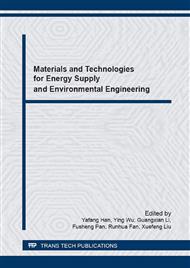[1]
R. Venkatasubramanian, E. Siivola, T. Colpitts, B. O'Quinn, Thin-film thermoelectric devices with high room-temperature figures of merit, Nature, 413(2001) 597-602.
DOI: 10.1038/35098012
Google Scholar
[2]
L.E. Bell, Cooling, heating, generating power, and recovering waste heat with thermoelectric systems, Science. 321(2008) 1457.
DOI: 10.1126/science.1158899
Google Scholar
[3]
G.D. Mahan, Good thermoelectric, Solid State Phys. 51(1998) 81-157.
Google Scholar
[4]
S.K. Bux, J.P. Fleurial, R.B. Kaner, Nanostructured materials for the thermoelectric applications, Chem. Commun. 46(2010) 8311-8324.
DOI: 10.1039/c0cc02627a
Google Scholar
[5]
W.S. Liu, X. Yan, G. Chen, Z.F. Ren, Recent advances in thermoelectric nanocomposites, Nano Energy. 1(2012) 42-56.
DOI: 10.1016/j.nanoen.2011.10.001
Google Scholar
[6]
X. Shi, H. Kong, C. -P. Li, C. Uher, J. Yang, Low thermal conductivity and high thermoelectric figure of merit in n-type BaxYbyCo4Sb12 double-filled skutterudites, Appl. Phys. Lett. 92(2008) 182101.
DOI: 10.1063/1.2920210
Google Scholar
[7]
J.P. Heremans, V. Jovovic, E.S. Toberer, A. Saramat, K. Kurosaki, A. Charoenphakdee, S. Yamanaka, G.J. Snyder, Enhancement of Thermoelectric Efficiency in PbTe by Distortion of the Electronic Density of States, Science. 321(2008) 554.
DOI: 10.1126/science.1159725
Google Scholar
[8]
D.J. Singh, W.E. Pickett, Skutterudite antimonides: Quasilinear bands and unusual transport, Phys. Rev. B. 50(1994) 11235-11238.
DOI: 10.1103/physrevb.50.11235
Google Scholar
[9]
T. He, J.Z. Chen, H.D. Rosenfeld, M.A. Subramanian, Thermoelectric Properties of Indium-Filled Skutterudites, Chem. Mater. 18(2006) 759-762.
DOI: 10.1021/cm052055b
Google Scholar
[10]
W.Y. Zhao, P. Wei, Q.J. Zhang, C.L. Dong, L.S. Liu, X.F. Tang, Enhanced Thermoelectric Performance in Barium and Indium Double-Filled Skutterudite Bulk Materials via Orbital Hybridization Induced by Indium Filler, J. Am. Chem. Soc. 131(2009).
DOI: 10.1021/ja8089334
Google Scholar
[11]
J. Gra, S. Zhu, T. Holgate, J. Peng, J. He, T.M. Tritt, High-Temperature Thermoelectric Properties of Co4Sb12-Based Skutterudites with Multiple Filler Atoms: Ce0. 1InxYbyCo4Sb12, J. Electron. Mater. 40(2011) 696-701.
DOI: 10.1007/s11664-011-1514-3
Google Scholar
[12]
H. Li, X.F. Tang, Q.J. Zhang, C. Uher, High performance InxCeyCo4Sb12 thermoelectric materials with in situ forming nanostructured InSb phase, Appl. Phys. Lett. 94(2009) 102114.
DOI: 10.1063/1.3099804
Google Scholar
[13]
G. Rogl, A. Grytsiv, K. Yubuta, S. Puchegger, E. Bauer, C. Raju, R.C. Mallik, P. Rogl, In-doped multifilled n-type skutterudites with ZT=1. 8, Acta. Mater. 95(2015) 201-211.
DOI: 10.1016/j.actamat.2015.05.024
Google Scholar
[14]
X. Shi, W. Zhang, L. D. Chen, J. Yang, Filling Fraction Limit for Intrinsic Voids in Crystals: Doping in Skutterudites, Phys. Rev. Lett. 95(2005) 185503.
DOI: 10.1103/physrevlett.95.185503
Google Scholar
[15]
P. Fan, Y. Zhang, Z.H. Zheng, W.F. Fan, J.T. Luo, G.X. Liang, D.P. Zhang, Thermoelectric Properties of Cobalt Antimony Thin Films Deposited on Flexible Substrates by Radio Frequency Magnetron Sputtering, J. Electron. Mater. 44(2015) 630-635.
DOI: 10.1007/s11664-014-3546-y
Google Scholar


